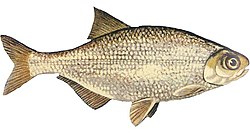| Joffrichthys | |
|---|---|
| Scientific classification | |
| Domain: | Eukaryota |
| Kingdom: | Animalia |
| Phylum: | Chordata |
| Class: | Actinopterygii |
| Order: | Osteoglossiformes |
| Family: | Osteoglossidae |
| Genus: | † Joffrichthys Li and Wilson, 1996 |
Joffrichthys is a genus of prehistoric bony fish. This North American genus includes three species, J. symmetropterus, J. tanyourus and J. triangulpterus. The last species is known from the Paleocene of the Sentinel Butte Formation of North Dakota. [1]


